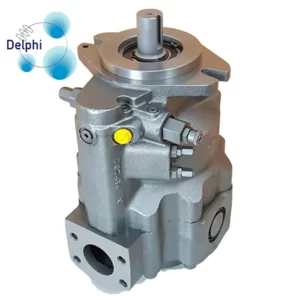In addition to the renewable energy applications mentioned earlier, Parker hydraulic pumps find use in various other areas within the renewable energy sector.
Here are some additional applications of Parker hydraulic pumps:
Biomass Power: Biomass power plants generate electricity by burning organic materials such as wood pellets, agricultural waste, or dedicated energy crops. Parker hydraulic pumps are utilized in biomass handling systems, including fuel feeders, conveyors, and ash handling equipment. They provide hydraulic power for material transportation and control, ensuring efficient and reliable operation.
Energy Storage: Energy storage systems play a crucial role in renewable energy integration and grid stabilization. Parker hydraulic pumps are employed in hydraulic energy storage systems, such as hydraulic accumulators. These systems store and release energy by compressing and decompressing a hydraulic fluid. Hydraulic pumps facilitate the charging and discharging of the accumulators, enabling efficient energy storage and retrieval.
Offshore Wind Power: Offshore wind farms harness wind energy in oceanic areas. Parker hydraulic pumps find application in offshore wind turbines for various purposes, including blade pitch control, yaw control (to align the turbine with the wind direction), and hydraulic braking systems. The pumps provide the necessary hydraulic power for precise control and safe operation of offshore wind turbines.
Concentrated Solar Power (CSP): Concentrated solar power systems use mirrors or lenses to concentrate sunlight onto a receiver, generating heat that drives a turbine or heat engine. Parker hydraulic pumps are utilized in CSP systems for thermal fluid circulation, heat transfer, and control. They ensure efficient operation and accurate control of the thermal energy transfer within the system.
Ocean Energy: Apart from wave and tidal power, the ocean energy sector encompasses other technologies such as ocean thermal energy conversion (OTEC) and salinity gradient power. Parker hydraulic pumps can be applied in these technologies for hydraulic power transmission, system control, and fluid circulation.
Hydrogen Production: Hydrogen is considered a promising energy carrier for the future. Parker hydraulic pumps are used in electrolysis systems for hydrogen production. They provide hydraulic power for the electrolyzer’s control and operation, ensuring the efficient production of hydrogen from water using renewable energy sources.
Parker hydraulic pumps demonstrate their versatility and applicability by supporting various aspects of renewable energy generation, storage, and control. rexroth a4vg series 40 By providing reliable and efficient hydraulic power, they contribute to the overall performance and viability of renewable energy systems across a wide range of applications.
How do Parker hydraulic pumps contribute to the efficiency of concentrated solar power systems?
Parker hydraulic pumps can contribute to the efficiency of concentrated solar power (CSP) systems in several ways.
Here are some ways in which Parker hydraulic pumps can enhance the efficiency of CSP systems:
Thermal Fluid Circulation: In CSP systems, a thermal fluid, such as a heat transfer oil or molten salt, is circulated to capture and transport the concentrated solar energy from the receiver to the power conversion system. Parker hydraulic pumps facilitate the efficient circulation of the thermal fluid, ensuring that the captured heat is transferred effectively and rapidly. Efficient fluid circulation minimizes heat losses and optimizes the overall energy conversion process, leading to improved system efficiency.
Precise Control of Flow and Pressure: Parker hydraulic pumps provide precise control over the flow rate and pressure of the thermal fluid in CSP systems. Accurate control is crucial for maintaining optimal operating conditions and maximizing energy transfer efficiency. Hydraulic pumps with variable displacement capabilities allow for fine adjustments in flow and pressure, enabling the system to respond dynamically to changing operating conditions and improving overall efficiency.
Heat Exchanger Operation: CSP systems often incorporate heat exchangers to transfer thermal energy from the thermal fluid to a working fluid, such as steam, which drives a turbine to generate electricity. Parker hydraulic pumps can facilitate the smooth operation of heat exchangers by maintaining the appropriate flow rates, enabling efficient heat transfer and minimizing thermal losses. This contributes to the overall efficiency of the energy conversion process.
Tracking System Control: CSP systems use solar tracking systems to ensure that the mirrors or lenses accurately focus sunlight onto the receiver. Parker hydraulic pumps play a role in controlling the movement of these tracking systems. Precise and responsive control provided by hydraulic pumps allows for accurate solar tracking, maximizing the concentration of solar energy onto the receiver and improving the system’s overall efficiency.
Maintenance and Reliability: Parker hydraulic pumps are designed for durability and reliability, even in demanding environments. Reliable operation reduces downtime and maintenance requirements, ensuring that the CSP system operates at peak efficiency for extended periods. The use of high-quality hydraulic pumps can contribute to the overall reliability and availability of the CSP system, maximizing its energy production and efficiency.
By providing efficient fluid circulation, precise control, reliable operation, and optimized heat transfer, Parker hydraulic pumps can help improve the overall efficiency of concentrated solar power systems. These enhancements contribute to the effective utilization of solar energy, increasing the electricity generation and the overall economic viability of CSP projects.
